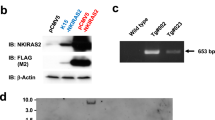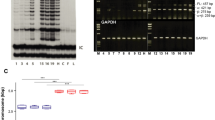Abstract
Upregulation of keratinocyte-derived VEGF-A expression has recently been established in non-neoplastic processes of skin such as wound healing, blistering diseases and psoriasis, as well as in skin neoplasia. To further characterize the effects of VEGF-A in skin in vivo, we have developed transgenic mice expressing the mouse VEGF120 under the control of a 2.4 kb 5′ fragment of keratin K6 gene regulatory sequences that confers transgene inducibility upon hyperproliferative stimuli. As expected from the inducible nature of the transgene, two of the three founder mice obtained (V27 and V208), showed no apparent phenotype. However, one founder (V2), mosaic for transgene integration, developed scattered red spots throughout the skin at birth. The transgenic offspring derived from this founder developed a striking phenotype characterized by swelling and erythema, resulting in early postnatal lethality. Histological examination of the skin of these transgenics demonstrated highly increased vascularization and edema leading to disruption of skin architecture. Expression of the transgene was silent in adult animals of lines derived from founders V27 and V208. Phorbol ester-induced hyperplasia resulted in transgene induction and increased cutaneous vascularization in adult transgenic mice of these lines. Skin carcinogenesis experiments performed on hemizygous crosses of V208 mice with activated H-ras-carrying transgenic mice (TG.AC) resulted in accelerated papilloma development and increased tumor burden. Previous results from our laboratory showed that VEGF upregulation is a major angiogenic stimulus in mouse epidermal carcinogenesis. By overexpressing VEGF in the skin of transgenic mice we now move a step further toward showing that VEGF-mediated angiogenesis is a rate-limiting step in the genesis of premalignant lesions, such as mouse skin papilloma. Our transgenic mice constitute an interesting model system for in vivo study of the cutaneous angiogenic process and its relevance in tumorigenesis and other skin diseases.
This is a preview of subscription content, access via your institution
Access options
Subscribe to this journal
Receive 50 print issues and online access
$259.00 per year
only $5.18 per issue
Buy this article
- Purchase on Springer Link
- Instant access to full article PDF
Prices may be subject to local taxes which are calculated during checkout
Similar content being viewed by others
Author information
Authors and Affiliations
Rights and permissions
About this article
Cite this article
Larcher, F., Murillas, R., Bolontrade, M. et al. VEGF/VPF overexpression in skin of transgenic mice induces angiogenesis, vascular hyperpermeability and accelerated tumor development. Oncogene 17, 303–311 (1998). https://doi.org/10.1038/sj.onc.1201928
Received:
Revised:
Accepted:
Published:
Issue Date:
DOI: https://doi.org/10.1038/sj.onc.1201928
Keywords
This article is cited by
-
NRP-1 interacts with GIPC1 and α6/β4-integrins to increase YAP1/∆Np63α-dependent epidermal cancer stem cell survival
Oncogene (2018)
-
VEGF-A acts via neuropilin-1 to enhance epidermal cancer stem cell survival and formation of aggressive and highly vascularized tumors
Oncogene (2016)
-
HIF-1α in Epidermis: Oxygen Sensing, Cutaneous Angiogenesis, Cancer, and Non-Cancer Disorders
Journal of Investigative Dermatology (2011)
-
A vascular niche and a VEGF–Nrp1 loop regulate the initiation and stemness of skin tumours
Nature (2011)
-
Emerging and Novel Therapeutic Approaches in the Treatment of Male Erectile Dysfunction
Current Urology Reports (2011)



